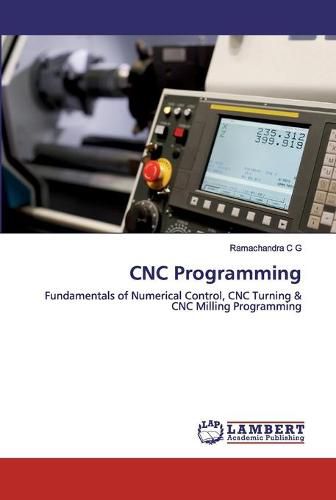Readings Newsletter
Become a Readings Member to make your shopping experience even easier.
Sign in or sign up for free!
You’re not far away from qualifying for FREE standard shipping within Australia
You’ve qualified for FREE standard shipping within Australia
The cart is loading…






This title is printed to order. This book may have been self-published. If so, we cannot guarantee the quality of the content. In the main most books will have gone through the editing process however some may not. We therefore suggest that you be aware of this before ordering this book. If in doubt check either the author or publisher’s details as we are unable to accept any returns unless they are faulty. Please contact us if you have any questions.
Numerical Control (NC) refers to the use of coded numerical information in the automatic control of equipment. Numerical Control can be defined as a kind of programmable automation in which the process is controlled by numbers, letters & symbols. The numbers letters & symbols are arranged as a program of instructions for a particular job. Such a program is called a part program. The alphanumerical data represent relative positions between a workhead & a workpart as well as other instructions needed to operate the machine. The workhead is a cutting tool or other processing apparatus, & the workpart is the object being processed. The major applications of Numerical Control are Machine tool applications, such as drilling, milling, turning, grinding etc., & Non-machine tool applications, such as assembly, Drafting. The most common applications of NC are in machine tool control. The machine tools and processes presently being controlled by powerful computers is termed as Computer numerical control (CNC) Machines. Computer numerical control is defined as an NC system whose Machine Control Unit is based on a dedicated microcomputer rather than on a hard-wired controller.
$9.00 standard shipping within Australia
FREE standard shipping within Australia for orders over $100.00
Express & International shipping calculated at checkout
This title is printed to order. This book may have been self-published. If so, we cannot guarantee the quality of the content. In the main most books will have gone through the editing process however some may not. We therefore suggest that you be aware of this before ordering this book. If in doubt check either the author or publisher’s details as we are unable to accept any returns unless they are faulty. Please contact us if you have any questions.
Numerical Control (NC) refers to the use of coded numerical information in the automatic control of equipment. Numerical Control can be defined as a kind of programmable automation in which the process is controlled by numbers, letters & symbols. The numbers letters & symbols are arranged as a program of instructions for a particular job. Such a program is called a part program. The alphanumerical data represent relative positions between a workhead & a workpart as well as other instructions needed to operate the machine. The workhead is a cutting tool or other processing apparatus, & the workpart is the object being processed. The major applications of Numerical Control are Machine tool applications, such as drilling, milling, turning, grinding etc., & Non-machine tool applications, such as assembly, Drafting. The most common applications of NC are in machine tool control. The machine tools and processes presently being controlled by powerful computers is termed as Computer numerical control (CNC) Machines. Computer numerical control is defined as an NC system whose Machine Control Unit is based on a dedicated microcomputer rather than on a hard-wired controller.